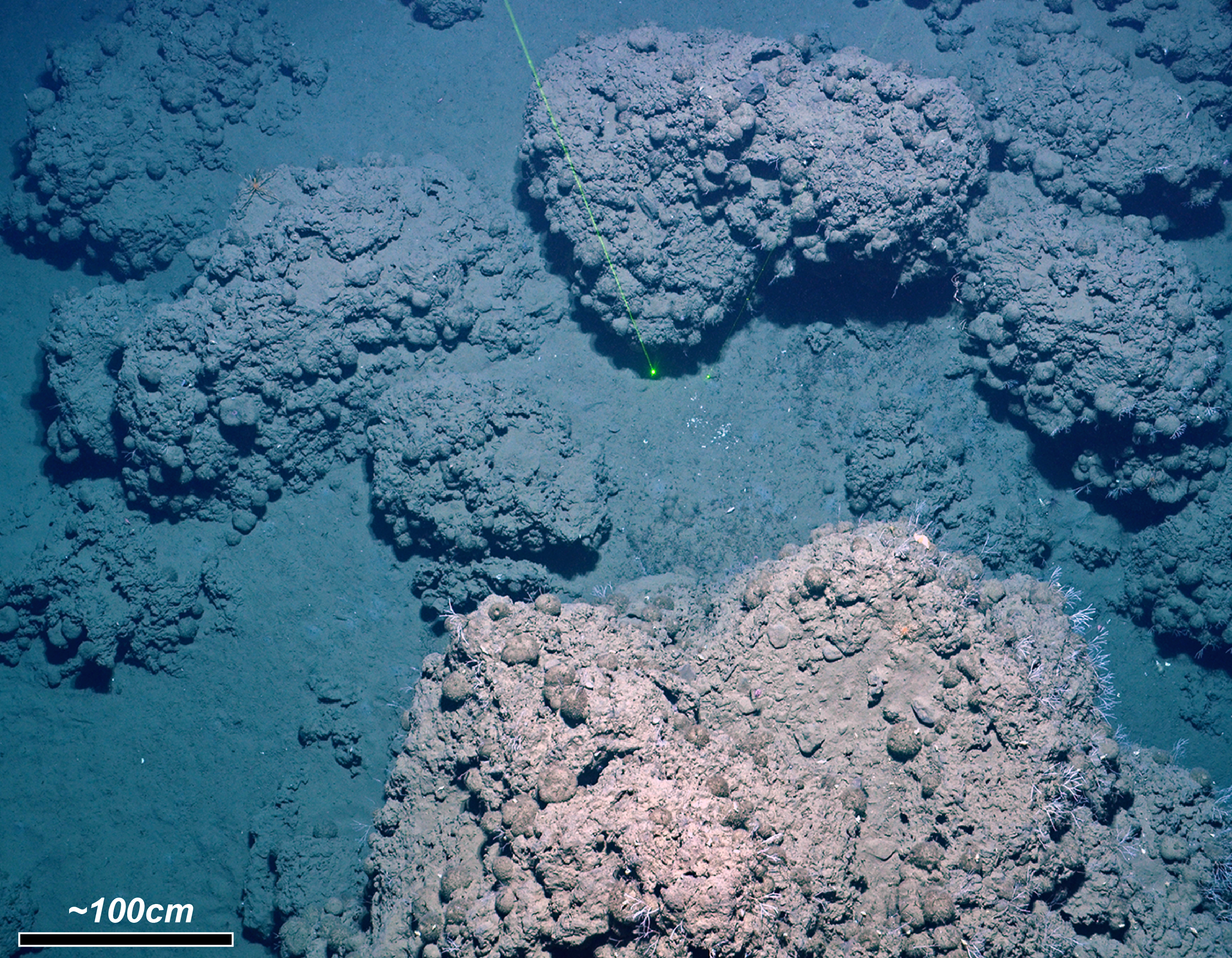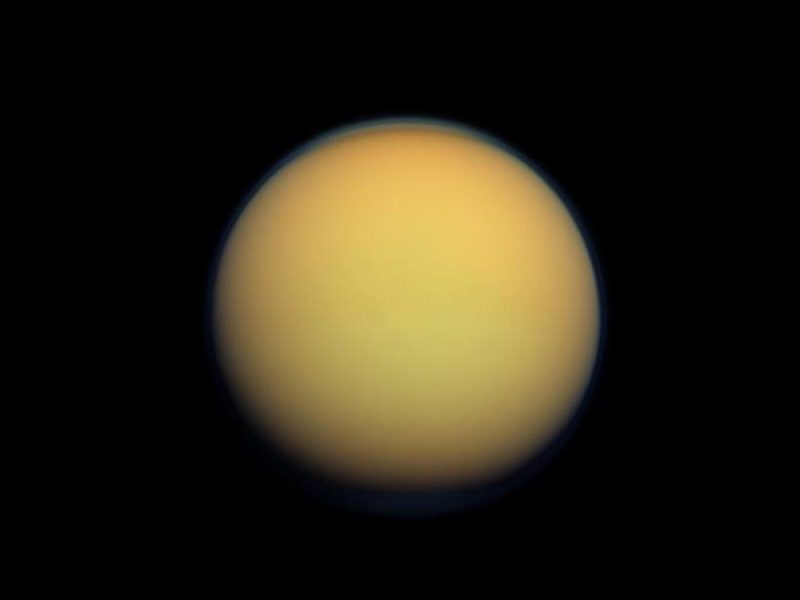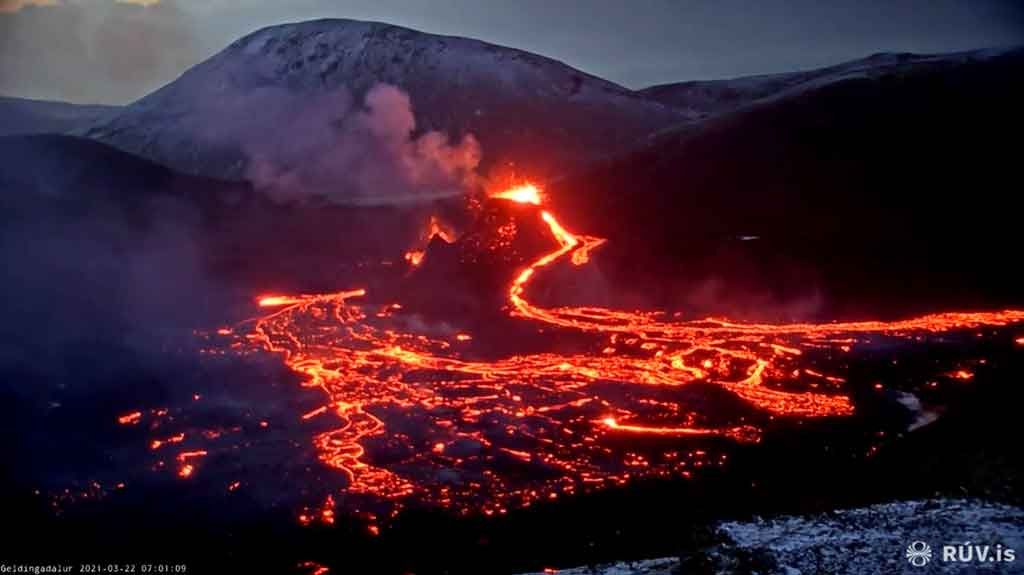After much “will it / won’t it” over the last few weeks in the wake of increased (and then decreased) seismic activity, an eruption in Iceland finally started with a brand new fissure near Fagradalsfjall. No lives are threatened, so Pamela is ecstatic. Plus, arctic methane, a new basalt type, spiders on Mars, Titan’s atmosphere, and an interview with PSI scientist Dr. Nick Castle about volcanoes.
Media
Transcript
Hello and welcome to the Daily Space. I am your host Dr. Pamela Gay.
And I am your host Beth Johnson.
And we are here to put science in your brain.
Today we’re going to be joined by Dr. Nick Castle to talk about Iceland’s latest volcanic eruption. Posing no risk to property and air traffic, this eruption is bringing a bit of fire to an otherwise icy and snowy landscape. Before we bring on our guests, however, let’s take a look at the news.
Our news today starts us out on the planet Mars and quickly brings us home to a Mars Simulation Chamber on Earth. I’m doing this story because it involves things called “Mars spiders” that, while not actually spiders, are still able to twig Beth’s arachnophobia. You have been warned.

For many years, orbiting space probes have spied strange features on Mars that appear like sponge paintings but are actually carved into the surface of Mars. It had been theorized that these features were caused by the sublimation of dry ice that had frozen in the soils over the Martian winter. Essentially, it gets so cold on Mars that, like a scene from The Day After Tomorrow, the air freezes solid; it just does so more slowly than in the movie, and it can end up in Martian soil.
Unlike water ice, melting dry ice goes straight from solid to gas, leaving behind a dry void where the ice used to be. While the theory that these patterns, called Martian Spiders, are dry ice voids matches that we’re seeing, we haven’t been able to visit any with a rover and actually verify our theories. So scientists did the next best thing and recreated the formation of these features in a chamber pumped down to the same low temperatures and pressures of Mars.
This work, published in Scientific Reports, was led by Lauren McKeown, who states: The experiments show directly that the spider patterns we observe on Mars from orbit can be carved by the direct conversion of dry ice from solid to gas. It is exciting because we are beginning to understand more about how the surface of Mars is changing seasonally today.
Mystery solved, those spiders – which I really wish were called something else – are nothing more than a sign of the changing seasons.
I wish they’d called those Mars Sponge patterns. I do not like spiders. Nope, not at all. Here on Earth, we also have cases of gases coming out of the ground, and no spider-like shapes are involved.
Beneath the surface of the Earth, methane gas is intermixed with water, forming pockets of methane hydrate. Basically, the surface pressure is high enough that the gas is kept locked in between the water molecules. It’s what we call “thermogenic methane” because it’s produced directly by geological processes deep underground. This is opposed to the biogenic methane we all know from methanogenic archaea in the guts of animals like cows (and some people… thank you, Mary Roach). Anyway, methane, of course, is a greenhouse gas, and that is a huge concern these days.

The methane that is nicely locked underground can come bursting or seeping out if the pressure on that ground decreases. And the pressure can decrease for several reasons, one of which is the loss of Arctic ice sheets and their tremendous weight. It’s definitely a negative feedback loop, and scientists are seeking to understand just how big a problem this could be in the near future. So a team took several sediment core samples off the coast of Svalbard in the Arctic Ocean to see how methane was released at the end of two periods of ice sheet loss.
Methane is one carbon atom and four hydrogen atoms, so when it’s released, carbonate-loving critters like foraminifera thrive and build shells with even more carbon-rich content than usual, and that carbon content can be tracked over time in the cores to see when the amount of methane changed. They found that as the ice melted, the pressure lessened, and methane was released in both violent bursts and slow seeping. Once the ice melted, the release of methane stabilized, but just how much methane was released in each episode is unknown. Since there are methane-loving critters, the methane is consumed and the calculations are complicated.
In fact, the team found massive layers of bivalves (think clams and oysters) in the cores, which confirms modern observations that these animals create massive communities around methane leaks. So while the methane release isn’t good for us, it is great for some seafloor critters. This work is published in the journal Geology with lead author Pierre-Antoine Dessandier.
As an astronomer, I’m used to seeing our universe has hydrogen, helium, and everything else, where I’m absolutely willing to refer to everything else as a metal. Today’s news is challenging this way of seeing things, and forcing me to consider the chemistry behind all the different ices and rocks that make up our world and others.
Here on Earth, as we’ll be discussing more in the context of Iceland later in the show, we can learn about our world’s history and internal structure from what we can find around volcanoes and coming out of their fissures and calderas. One of the most fascinating places to explore is the ocean floor.
In new research in the Pacific Ocean, a team from Leeds’ Institute of Geophysics and Tectonics has obtained new samples by sending their equipment six kilometers down to the floor of the ocean and then drilling a further 1.5 kilometers. The site of their drilling was along the Pacific Ring of Fire, a region that has been geologically active for at least 50 million years. Their particular drill site was off the coast of Japan, and according to researcher Ivan Savov: This was one of the deepest waters ever to be considered for drilling, using a research vessel specifically designed for such challenging deep-sea environments.

When lava cools into a solid, that solid is called basalt, and Savov goes on to say: Basalt is among the most common types of rock on earth. We were looking for basalt that was formed during early Ring of Fire volcanic eruptions.
They found the basalt, and they found it was like nothing ever before seen, with a unique chemical and mineral makeup that indicates early eruptions were both more powerful and more voluminous than previously thought. Savov adds: Now that we know where and how this rock type is formed, we anticipate that many other rocks that we know were originally formed by ocean floor eruptions will be re-examined and potentially alter our wider understanding of the basalt formation.
There are two places humans are only beginning to explore: the bottom of the ocean and outer space. Let’s face it, planets like to hide their secrets, and our Earth is counted among that secretive crew.
We don’t talk about Titan all that much around here, but all that is going to change in the next few years. NASA has chosen the Dragonfly as the next New Frontiers mission, and the little rotorcraft is currently expected to launch in 2027. Which seems like a long time from now, and definitely feels like a long time since the end of the Cassini mission in 2017. I’m still sad about the end of Cassini. I won’t lie. But that mission is still the gift that keeps on giving.

A team of scientists, led by Rajani Dhingra, continues to analyze Cassini data with regards to Titan. And they’ve published a new paper in Geophysical Research Letters that provides more evidence for rainfall on Titan.
That’s right. Rainfall. You see, Titan may be a moon of Saturn, but it’s also the most Earth-like body in the solar system that isn’t actually Earth. It has a mostly nitrogen atmosphere; there are clouds, seas, rivers, lakes, and even rain. Now, the lakes are made of hydrocarbons like methane and ethane instead of water, and the surface pressure is about fifty percent higher than Earth’s, but still. Those lakes and seas might harbor life. It would be life that uses different chemistry from most life here on Earth, though.
Hence the continuing interest in Titan. And back in 2019, this research group published a paper, also in Geophysical Research Letters, that outlined the observational evidence for rainfall at the north pole of Titan. Due to its axial tilt, Titan also has four seasons, which last about 7.5 years each, and these observations were conducted by Cassini during Titan’s summer. Now, Cassini had already observed precipitation at the south pole of the moon, but surprisingly, not in the northern hemisphere where the majority of lakes and seas are located.
So this team finds a bright ephemeral feature (BEF) that appears to be the result of sunlight reflecting off a puddle, like sunlight would off of wet pavement here on Earth. The rainfall that caused this potential puddle should also have affected the temperature, but the event was so short-lived that Cassini’s observations weren’t precise enough to detect any change.

The new study, however, details another bright ephemeral feature that came from the next pass of Cassini later the same year, and that detection was solid enough to resolve a temperature drop of 1.2 Kelvin around the BEF compared to the area surrounding it. By the next flyby, the BEF was gone. Dhingra sums up the research: We were fortunate enough to have that number of spectra to see a perceptible temperature difference in a single flyby in a single day on Titan, so we have for the first time probably looked at the weather on Titan. We don’t know the fate of the rainfall.
Roger Clark, a senior scientist at the Planetary Science Institute who was not involved in the research, notes that “a wet surface, ice, or even clouds can all cause the kind of spectral reflections that have been detected on Titan.” So while this research seems solid, we won’t know for certain until Dragonfly gets to Titan in 2035 and can make its own observations.
As always, we’ll keep you up to date with all the Dragonfly mission news and science as it happens.
Several weeks ago, we shared with you news that increased tremors on the Reykjanes peninsula seemed to indicate magma was on the move and that a volcanic eruption was possible. Well, last Friday night, that eruption finally occurred!
For the first time in 900 some years, the Fagradalsfjall Volcano began to erupt. This is a fissure volcano, which to my astronomer’s eye, basically means it appears that the earth has cracked open, allowing magma from deep below to ooze and fountain out, building up a small cone and lava field. This volcano is considered safe with the exception of periodic clouds of poisonous gas; it is neither expelling ash high into the air nor threatening homes or life with lava. The only real concern, so far, has been for possible archaeological sites.

According to the Icelandic news site, mbl.is, archaeologist Oddgeir Osaksen raced to the site by helicopter after the eruption started, but didn’t find any burial sites, stating: I did not see the valley in its entirety before it went under the lava, so I do not dare to swear that nothing went under, but judging by aerial photographs it is unlikely.
For now, this volcano is calmly filling the valley it is located in, and if the eruption continues for tens of days, it may overfill it and spill into neighboring regions.
Volcanologists from the Iceland Met Office have already taken and processed samples of the lava emerging onto the surface, and it appears to have come directly from the Earth’s mantle at a depth of 17-20 kilometers. This kind of direct connection to the region below the Earth’s crust is rare, and I look forward to more footage of volcanologists getting crazy close, cooking sausages over the lava, and collecting more samples to science upon their return to their labs.
[Interview]
This has been the Daily Space.
Learn More
Martian “Spiders” Form From Sublimation of Carbon Dioxide Ice
- Trinity College Dublin press release
- “The formation of araneiforms by carbon dioxide venting and vigorous sublimation dynamics under martian atmospheric pressure,” Lauren McKeown et al., 2021 March 19, Scientific Reports
Loss of Arctic Ice Sheets Will Lead to Methane Release
- GSA press release
- “Ice-sheet melt drove methane emissions in the Arctic during the last two interglacials,” P.-A. Dessandier et al., 2021 March 22, Geology
New Basalt Type Found Beneath Pacific Ocean
- EurekaAlert press release
- “Basalt derived from highly refractory mantle sources during early Izu-Bonin-Mariana arc development,” He Li et al., 2021 March 19, Nature Communications
Cassini Data Used to Identify Rainfall-Caused Drop in Temperature on Titan
- Eos article
- “Observational Evidence for Summer Rainfall at Titan’s North Pole,” Rajani D. Dhingra et al., 2019 January 16, Geophysical Research Letters
- “Lower surface temperature at Bright Ephemeral Feature site on Titan’s north pole,” Rajani D. Dhingra et al., 2021 February 6, Geophysical Research Letters
New Fissure Eruption Near Fagradalsfjall in Iceland
- Eruption Mar 2021 on the Reykjanes Peninsula: activity updates (Volcano Discovery)
- Live feed from Iceland volcano (RUV.is)
Credits
Written by Pamela Gay and Beth Johnson
Hosted by Pamela Gay and Beth Johnson
Audio and Video Editing by Ally Pelphrey
Content Editing by Beth Johnson
Intro and Outro music by Kevin MacLeod, https://incompetech.com/music/


 We record most shows live, on Twitch. Follow us today to get alerts when we go live.
We record most shows live, on Twitch. Follow us today to get alerts when we go live.